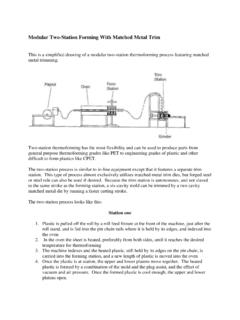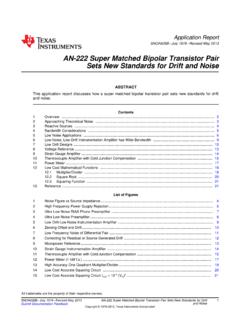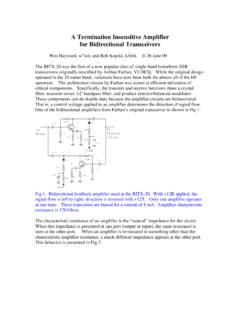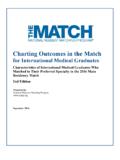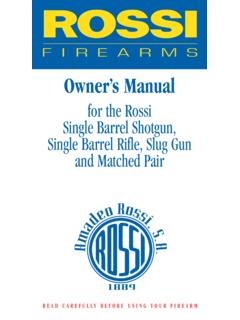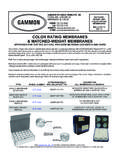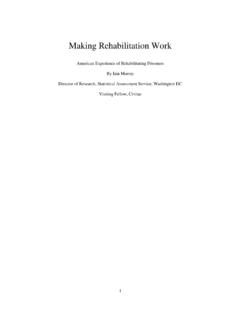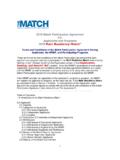Transcription of Section 4.8: Undesirable effects
1 Section : Undesirable effects SmPC training presentation Note: for full information refer to the European Commission's Guideline on summary of product characteristics (SmPC). SmPC Advisory Group An agency of the European Union Index I. General objectives II. Key principles Summary of safety profile Tabulated list of adverse reactions Description of selected adverse reactions <Paediatric population>. <Other special population>. III. Additional information Guidance on the estimation of frequency of adverse reactions Information not to be included IV. FAQs 2 Section : Undesirable effects I. General objectives of Section This Section should include all adverse reactions from clinical trials, post- authorisation safety studies and spontaneous reporting for which, after thorough assessment, a causal relationship between the medicinal product and the adverse event is at least a reasonable possibility, based for example, on their comparative incidence in clinical trials, or on findings from epidemiological studies and/or on an evaluation of causality from individual case reports The content of this Section should be justified in the clinical overview of the marketing authorisation application based upon a best-evidence assessment of all observed adverse events and all facts relevant to the assessment of causality, severity and frequency Guidance regarding clinical overview may be found in the ICH Topic M 4 E.
2 Click here for Section of this guideline Whole Section should be worded in CONCISE AND SPECIFIC LANGUAGE. Information not to be 3 Section : Undesirable effects included in Section Section index Summary of the safety profile Provide information on the most serious and/or most frequently occurring adverse reactions. Frequencies to be stated as accurately as possible HELPFUL to indicate timing when adverse reaction occurs information SmPC examples on reactions associated with long-term use, or adverse reactions that are 1 safety profile frequent in the beginning of treatment but may disappear with continuation 2 safety profile Cross-reference to Section if relevant risk minimisation 3 safety profile -cross measures in that Section reference to Consistency with: 4 safety profile-risk Important identified risks in Safety Specification of Risk management plan Management Plan 5 safety profile Table of Adverse Reactions consistent with table of adverse reactions 4 Section : Undesirable effects Section index Example 1-safety profile Most serious and/or frequently occurring adverse reaction.
3 Frequencies stated as accurately as possible Active substance X capsules Summary of the safety profile The most important serious adverse reactions associated with active substance X in patients with solid tumours were pulmonary embolism (1%), thrombocytopoenia (1%), tumour haemorrhage ( ), febrile neutropoenia ( ) and hypertension ( ). 5 Section : Undesirable effects a. summary of safety profile Section index Example 2-safety profile Most serious and/or frequently occurring adverse HELPFUL to indicate timing when adverse reaction occurs reaction. Frequencies stated as accurately as possible Active substance X solution for injection in pre-filled syringe Summary of the safety profile The highest incidence of adverse reactions associated with active substance X. therapy is related to flu-like syndrome. Flu-like symptoms tend to be most prominent at the initiation of therapy and decrease in frequency with continued treatment.
4 Approximately 70% of patients treated with active substance X can expect to experience the typical interferon flu-like syndrome within the first six months after starting treatment. 6 Section : Undesirable effects a. summary of safety profile Section index Example 3-safety profile Most serious and/or frequently occurring adverse Cross-reference to Section if relevant risk minimisation reaction. Frequencies stated as accurately as possible measures have been proposed in that Section Active substance X 30 ml solution for injection or infusion Summary of the safety profile Rare pulmonary Undesirable effects including interstitial pneumonia, pulmonary oedema and pulmonary infiltrates have been reported in some cases with an outcome of respiratory failure or adult respiratory distress syndrome (ARDS) which may be fatal (see Section ). Special warnings and precautions for use Rare pulmonary Undesirable effects , in particular interstitial pneumonia, have been reported after GCSF.
5 Administration. Patients with a recent history of pulmonary infiltrates or pneumonia may be at higher risk. The onset of pulmonary signs such as cough, fever and dyspnoea in association with radiological signs of pulmonary infiltrates and deterioration in pulmonary function may be preliminary signs of Adult Respiratory Distress Syndrome (ARDS). Active substance X should be discontinued and appropriate treatment given in these cases. 7 Section : Undesirable effects a. summary of safety profile Section index Example 4-safety profile Most serious and/or frequently occurring adverse Consistency with important identified risks in Safety reaction. Frequencies stated as accurately as possible Specification of Risk Management Plan Active substance X 30 ml solution for injection or infusion Rare pulmonary Undesirable effects including interstitial pneumonia, pulmonary oedema and pulmonary infiltrates have been reported in some cases with an outcome of respiratory failure or adult respiratory distress syndrome (ARDS) which may be fatal (see Section ).
6 Table Summary of Risk Management Plan Safety concern Proposed Proposed risk minimization activities pharmacovigilance activities Important identified risks Adult respiratory distress Routine Routine risk minimisation (labelling). syndrome (ARDS) (PT: acute pharmacovigilance Pulmonary Undesirable effects including interstitial pneumonia, pulmonary oedema and respiratory distress syndrome) including pulmonary infiltrates in some cases with an outcome of respiratory failure or adult Interstitial pneumonia (PT: presentation of respiratory distress syndrome (ARDS) which may be fatal are mentioned in Section interstitial lung disease) collated data in the of the SmPC . Mention in Section of the SmPC that patients with a recent history Pulmonary oedema (PT) corresponding of pulmonary infiltrates or pneumonia may be at higher risk. The onset of pulmonary Pulmonary infiltrates (PT: lung chapter of the PSUR signs such as cough, fever and dyspnoea in association with radiological signs of infiltrates) pulmonary infiltrates and deterioration in pulmonary function may be preliminary signs Respiratory failure (PT) of ARDS.
7 8 Section : Undesirable effects a. summary of safety profile Section index Example 5-safety profile Most serious and/or frequently occurring adverse reaction. Frequencies stated as accurately as possible Consistency with Table of Adverse Reaction Active substance X mg hard capsules or infusion Summary of the safety profile The most commonly reported adverse reactions are gastrointestinal, including nausea (38%) and vomiting (23%), especially during titration. Tabulated Summary of Adverse Reactions (Extract). Gastrointestinal disorders Very common Nausea Very common Vomiting 9 Section : Undesirable effects a. summary of safety profile Section index Tabulated list of adverse reactions Introduce table with short paragraph stating source of safety database 6 Introduction to tabulated list Single table (or structured listing) of all adverse reactions with respective frequency category See next slide for table structure.
8 Separate tables are acceptable in exceptional cases where adverse profiles markedly differ depending on the use of the product. For example, it might be the case for a product used for different indications ( an oncology and a non oncology indication) or at different posologies 10 Section : Undesirable effects Section index Tabulated list of adverse reactions (Table structure). Present according to MedDRA system organ classification A pragmatic approach to the location of terms should be taken in order to make the identification of adverse reactions simpler and clinically appropriate for the reader Click here for access to the Annex MedDRA of SmPC guideline Frequency Grouping Within each Very common ( 1/10);. SOC, adverse reactions should be ranked under common ( 1/100 to <1/10);. headings of frequency, most frequent reactions first uncommon ( 1/1,000 to <1/100);. Frequency grouping, adverse reactions should be rare ( 1/10,000 to <1/1,000).
9 Presented in order of decreasing seriousness very rare (<1/10,000);. Frequency not known (cannot be estimated from the available data). Where additional details about an adverse reaction are described after the tabulated list, the reaction concerned In some cases for common or very common reactions, should be highlighted in the table, for example with an and when necessary for clarity of information, frequency asterisk referring to the detailed description figures may be presented 11 Section : Undesirable effects b. tabulated list of adverse reactions Section index Example 6-introduction to tabulated list Introduce table with short paragraph stating ( from clinical trials, post-authorisation source of safety database safety studies or spontaneous reporting). Active substance X 25 mg hard capsules Tabulated list of adverse reactions Adverse reactions associated with active substance X obtained from clinical studies and post-marketing surveillance are tabulated below.
10 12 Section : Undesirable effects b. tabulated list of adverse reactions Section index Description of selected adverse reactions Information characterising individual serious and/or frequently 7 description occurring adverse reactions, or those where there have been 8 description reports of particularly severe cases 9 description 10 description Description of specific adverse reactions which may be useful to 11 description prevent, assess or manage the occurrence in clinical practice 12 description FREQUENCY should be described together with for example information on: reversibility, time of onset, severity, duration, mechanism of action (if of clinical relevance), dose relationship, risk factors, differences between different dosage forms Combination products: a statement at the beginning of this Section pointing out which particular adverse reactions are usually attributable to which active substance of the combination, where known 13 Section .










